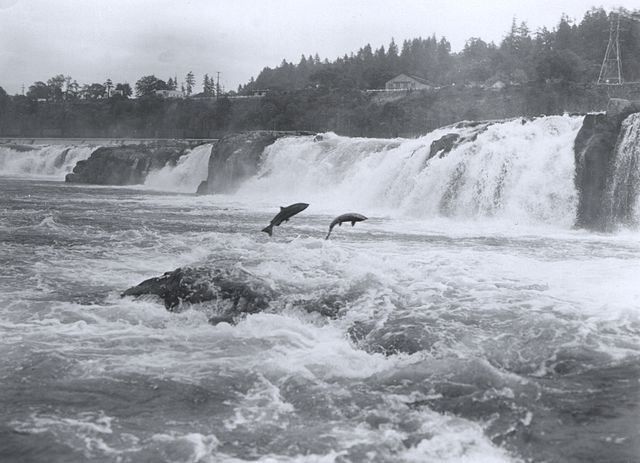
Why do salmon swim upstream? They return to the place they were born to lay their eggs.
Salmon are born in freshwater streams. The adult salmon lay eggs in the sand and gravel at the bottom of the river, which hatch and become baby salmon, which are called alevins. The alevins still have a yolk sac from the egg attached to them and this gives them enough food for about a month as they grow. Once that sac is empty, they eat and start to grow bigger, and they are called fry. These fry stay in the freshwater for several months while they become bigger and then head down the river towards the sea. One of the cues that starts them on their journey is when their adult scales grow. The fry get as far as the estuary at the end of the river where they spend another few months eating as much as they can to grow bigger and trying to adjust their bodies to the saltwater conditions they are going to live in.
The majority of fish are either saltwater fish or freshwater fish. Both environments are very different and fish need a number of adaptations to survive. In saltwater, fish need to constantly drink water because salt pulls water out of the cells. That is the reason why we can’t drink saltwater. Our kidneys can’t remove enough of the salt from our blood and it will pull the water out of our cells until we dehydrate and die. Saltwater fish obviously don’t dehydrate and die. The salt in the water also pulls the water out of their cells, so they have evolved two ways to cope. They constantly take water in to replenish what is pulled out. They take in and lose water through their gills and skin constantly. Liters of water a day. Secondly, their kidneys can pull most of the salt out of their blood and pass it out in the fish’s urine. Their urine is very concentrated because they want to lose as much salt as possible, yet keep as much water as possible. Salmon have to be able to survive in both environments. Fish that can move in both environments are called anadromous.
The problem salmon have is that in freshwater, there is not enough salt in the water and they take in more water they need and constantly lose salt. In saltwater, it is the opposite. They take in more salt than they need and are constantly losing water. Salmon are able to survive in both environments because their body has a switch. When they are born, they are freshwater fish and their gills don’t take in much water, they only let it run over them so they can get the oxygen from it. The salmon fry takes salt out of the water with a pump in its gills, but its kidneys don’t remove the salt because it needs it. At the same time, it produces as much urine as possible to remove the excess water from its body. When they swim to the estuary at the end of the river and are exposed to a mix of freshwater and saltwater, the salmon fry’s bodies change. The pump in its gills that takes salt out of freshwater reverses direction and starts to pump salt out of the salmon and into the water passing through it. The salmon also starts to drink far more water and its kidneys remove as much of the salt as they can before passing it out of the body in very concentrated urine. When the salmon returns to the freshwater river to spawn, the process reverses itself.
So, why do salmon come back to the same river and swim up it? Salmon lay their eggs in a freshwater river because there are usually fewer predators. The moving water keeps the salmon eggs and fry safer than they would be in the sea. However, when salmon are adults, they are so big that the sea is no problem for them and they can find far more food there than they could in a river. This is why they are born in a river and go to the sea. Unfortunately, the only way to repeat the cycle is if the salmon can get back to the place where they were born. To do this, they have to swim a very long way against the current. It is easy for the fry to reach the sea because they just move with the current. Getting back is not so easy. Before they start the attempt, the adult salmon eat as much as they can to build up their energy. By the time they reach the birthing grade, the effort of swimming against the current has taking nearly all of their energy and after laying their eggs, most of the salmon die. And this is what I learned today.
Image By Unknown author – NOAA Photo Library, Public Domain, https://commons.wikimedia.org/w/index.php?curid=18798546
Sources
https://www.nps.gov/olym/learn/nature/the-salmon-life-cycle.htm
https://www.vitalchoice.com/articles/food-facts/why-do-salmon-swim-upstream
https://www.amnh.org/exhibitions/water-h2o–life/life-in-water/surviving-in-salt-water
https://ciaanet.org/osmoregulation-how-salmon-survive-in-freshwater-and-saltwater
